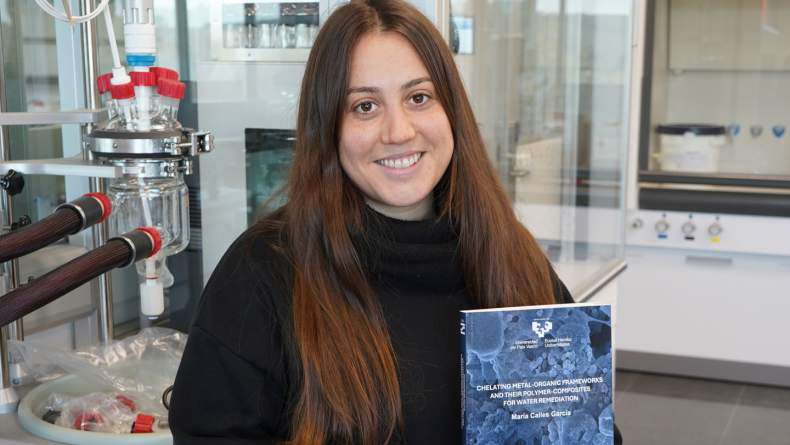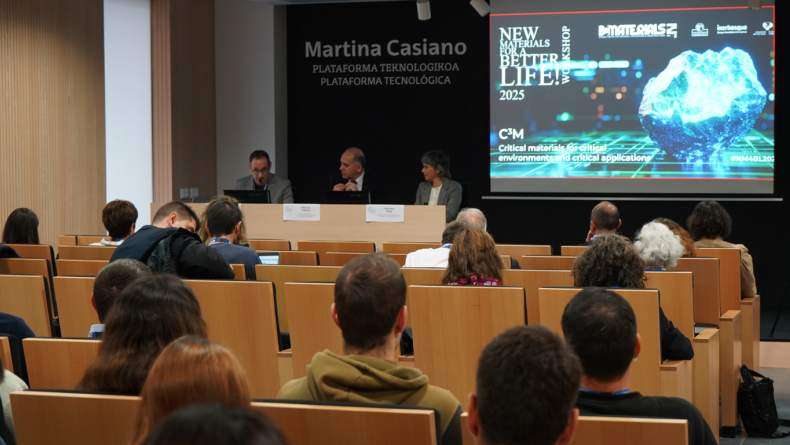BCMaterials Fortnightly Seminar #72 Leticia Fernández - Pablo Bendialauneta - Asier Galicia - Asier Rodriguez

LETICIA FERNÁNDEZ
(BCMATERIALS)
Synthesis and characterization of an ionic polyoxovanadate-based hybrid compound
The type I hybrid polyoxovanadate−based compound [{CuL(H2O)2}2{H2(Me2en)}][(V10O28)]∙10H2O was synthetized by reacting [VO3]− anions, Me2en (Me2en = N,N´−dimethylethylendiamine) and Cu−L metallorganic complexes (L = N,N´−dimethyl−N−(2−pyridylmethyl)ethylene−1,2−diamine) in acidic aqueous medium under mild conditions. The characterization of the title hybrid polyanion was carried out by infrarred spectroscopy (FT−IR), elemental analyses (EA) as well as thermogravimetric (TGA/DTA) measurements, which were in good agreement with the results observed by single-crystal X-ray diffraction technique (sc-XRD). The latter reveals a supramolecular architecture formed by decavanadate clusters and Cu(II)−L moieties in such a way that a hybrid layered arrangement sustained by a strong H−bonding network is generated where {H2(Me2en)} cations occupy the interlamellar space.
PABLO BENDIALAUNETA
(BCMATERIALS)
ΔE EFFECT, MAGNETOSTRICTION AND HYSTERESIS STUDY OF VITROVAC 4040 AND X6 FERROMAGNETIC MATERIALS
Ferromagnetic materials have two intrinsic properties that relate the change in magnetization to a deformation of the material and vice versa. These properties are magnetoelasticity and magnetostriction.
By applying constant and oscillating magnetic fields through a system of coils to our ferromagnetic samples, I have been able to determine how its Young Modulus changes (ΔE effect). Furthermore, I have measured the deformation of the samples by adhering an extensiometric gauge and changing the constant magnetic field applied to the material. These two studies give us an idea of how the geometrical and mechanical properties of ferromagnetic materials change under the presence of magnetic fields.
I have also studied the hysteresis cycles of both materials using the VSM machine.
Finally, I have simulated different geometries to obtain a defined deformation of our samples under a load of 30 mbar, and for the optimal geometry found, I have run a simulation of the modal frequencies to see how it will oscillate under that pressure.
The materials I have utilized are Vitrovac 4040 and X6 with different lengths for both of them and widths of 6, 4 and 2 mm for the Vitrovac 4040 samples. The results obtained should help in the implementation of these materials in sensors and actuators.
ASIER GALICIA
(BCMATERIALS)
Fabricación de una plataforma para el control remoto de bacterias magneto tácticas
Durante las practicas de verano se ha construido un prototipo de plataforma magnetot áctica, consistente en unas bobinas de Helmholtz en configuración 3D y un microscopio óptico integrado, con la que se ha observado y analizado el comportamiento de las bacterias magnetot ácticas bajo la actuación ón remota de un campo magnético aplicado. En concreto, se ha analizado la respuesta de las bacterias con distintos campos aplicados, la velocidad de movimiento y de rotación de las bacterias, y la posibilidad de agruparlas en un volumen determinado. Para este ultimo apartado, se han desarrollado varias simulaciones con las que se pretenden observar cuales son las configuraciones del campo ´magnético para optimizar el proceso.
ASIER RODRIGUEZ
(BCMATERIALS)
Synthesis and characterization of a new functionalised Metal-Organic Framework (MOF) with potential biological applications
Metal-Organic Frameworks (MOFs) are a porous coordination networks assembled from metal and organic units. These materials have been investigated for various applications including gas storage and separation, biomedicine and catalysis. In this project, the UiO66 zirconium MOF has been synthesised and characterized towards three main goals, i) reduction on the particle size, ii) inclusion of ligand defects and iii) inclusion of hydroxyl groups in the organic linkers. Functionalized UiO66 compound have been used as nano-carriers for the encapsulation of low molecular weight antimicrobial agents (such as β-Alanine). The nanostructured materials were characterized by Infrared (IR) spectroscopy, X-Ray Diffraction (XRD), Z potential determination and Thermogravimetric (TG) analysis in order to study their structure and adsorption capacity over β-Alanine.
Related news
María Calles, BCMaterialseko doktore berria
María Calles García zoriondu nahi dugu UPV/EHUn Materialen Zientzia eta Teknologian doktoretza lortzeagatik. Abenduaren 4an Maríak ‘Chelating Metal-Organic Frameworks and Their Polymer-Composites…Bartzelonako Mikroelektronika Institutuko ikertzaileekin hitzaldi gonbidatua (abenduak 3)
Datorren abenduaren 3an, 12:00etatik aurrera Leioako Martina Casiano auditorioan, BCMaterialsek Bartzelonako Mikroelektronika Institutuko (IMB-CNM) (CSIC) Antón Guimerà eta Xavier Illa ikertzaile…Hitzaldi gonbidatua Liu Yaorekin metal-litiozko bateriei buruz (abenduak 2)
Datorren astelehenean, abenduaren 2an, Liu Yao Shanghai Institute of Applied Physics-eko irakasleak "Li Metal Batteries: From Liquid to Solid-State" hitzaldia aurkeztuko du BCMaterials-en. Hitzaldia…BCMaterials-en urteko workshoparen arrakasta, material kritikoei eskainia
BCMaterialsen urteko workshoparen 2025. edizio arrakastatsuak ehun bat lagun bildu zituen azaroaren 19an Leioan, artearen egoera aztertzeko eta material kritikoei, materialen aplikazio kritikoei eta…



